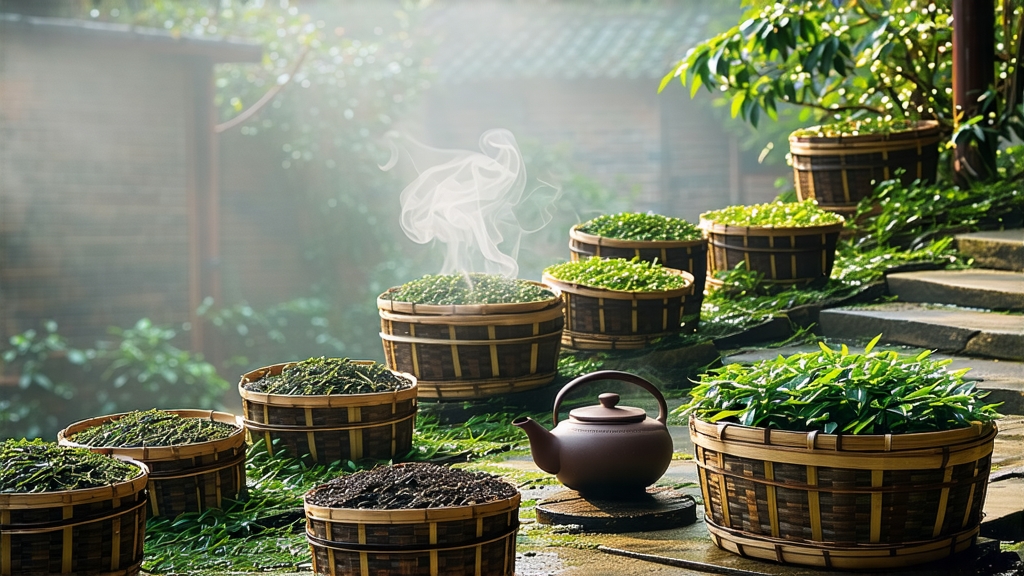
Tucked away in the southern folds of China’s Guangxi Zhuang Autonomous Region, Liu Bao tea has spent centuries perfecting the art of subtlety. While Pu-erh often hogs the international spotlight, Liu Bao—literally “Six Forts”—quietly ferments in bamboo baskets, acquiring a mellow earthiness that once fueled the caravan bells on the Tea Horse Road. To understand Liu Bao is to listen to a slower, deeper rhythm of Chinese tea culture, one that beats in humid storerooms and limestone caves rather than on auction blocks.
Historical whispers place Liu Bao on merchant boats sailing down the Xun River as early as the Ming dynasty. From the port of Wuzhou, compressed baskets of dark leaves traveled to Hong Kong, Macau, and finally Southeast Asia, where dock workers noticed the tea settled their stomachs after greasy dockside meals. By the Qing era, Liu Bao had become a currency of sorts: one basket could pay a laborer’s month-long wage in Kuala Lumpur, and British medical journals in Singapore listed “Lieu-Pow” as a remedy for beriberi. The 1960s saw state-owned factories standardize the craft, yet the soul of Liu Bao remained in the micro-climates of the small mountain villages of Cangwu and Teng counties.
Unlike the broad “dark tea” umbrella that shelters Pu-erh, Qian Liang, and Hubei border teas, Liu Bao occupies its own branch on the fermentation family tree. Purists recognize three traditional grades—First, Second, and Third Liu Bao—based on leaf maturity and plucking standard, but modern market segmentation has added “Special” and “Premium” tiers that celebrate single-grove harvests. A further distinction lies in aging vessel: bamboo-liner baskets encourage gentle microbial breathing, while clay jars lend mineral notes, and cave storage amplifies humidity-driven mellowness. The result is a spectrum that can taste of dried longan one year and of petrichor-soaked bark the next, all under the Liu Bao name.
The craft begins in late April, when the first subtropical rains plump the medium-leaf Da Bai cultivar. Pickers take a bud-and-three-leaf standard, slightly tougher than green-tea etiquette, because the leaf must withstand weeks of moisture without collapsing. After a brief withering under filtered sunlight, the leaves are wok-fried at 180 °C for eight minutes—long enough to kill green enzymes yet short enough to preserve leaf integrity. While still warm, they are rolled into tight cords that will later trap humidity during fermentation. The signature “dui wo” (wet-piling) phase follows: leaves are piled 70 cm high, misted with mineral-rich mountain water, and covered with jute sacks. For the next 25 days, internal temperatures oscillate between 45 °C and 55 °C, orchestrating a microbial waltz dominated by Aspergillus niger, Blastobotrys adeninivorans, and a local yeast dubbed Wuzhouensis No. 3. Turners shuffle the pile every five days, using a hoeing motion borrowed from rice-field farming, ensuring every leaf kisses oxygen and re-enters the ferment core. Once the leaf color turns chestnut and the aroma shifts from grassy to dried jujube, the pile is dismantled and sun-dried on bamboo screens for three consecutive mornings, a ritual believed to “anchor” the flavor.
Post-fermentation, the tea is still only half-born. Basket compression—once a practical measure for porters—now becomes a maturation catalyst. Leaves are steamed for 30 seconds, rammed into 50 kg cylindrical bamboo baskets lined with wild banana leaf, and pressed with a 30 kg stone disc. The baskets rest in riverside warehouses where humidity hovers at 80 % and temperatures refuse to drop below 22 °C even in January. Over years, the tea oxidizes slowly, trading astringency for a dark honey viscosity. A 1996 Liu Bao might reveal camphor and dark chocolate, while a 1983 cave-aged vintage can echo wet stone and sandalwood, textures that Pu-erh drinkers often describe as “older brother” rather than twin.
To brew Liu Bao is to court patience. Begin with 5 g of leaf—enough to fill a small white porcelain gaiwan—and awaken it with a 10-second rinse at 100 °C. Discard the rinse; think of it as shaking hands before conversation. The first formal infusion lasts